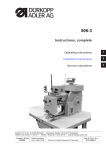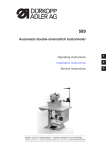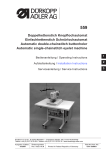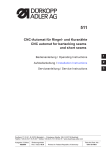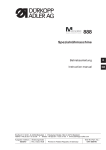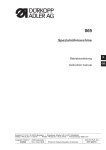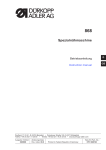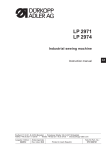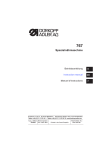Download Duerkopp Adler 550-767 Operating instructions
Transcript
550-767 Gestalteter Arbeitsplatz für Seitenairbag - Sollreißnaht Engineered work station for side airbag tearing seam Bedienanleitung / Operating instructions Aufstellanleitung / Installation instructions Postfach 17 03 51, D-33703 Bielefeld Potsdamer Straße 190, D-33719 Bielefeld Telefon +49 (0) 5 21/ 9 25-00 Telefax +49 (0) 5 21/ 9 25 24 35 www.duerkopp-adler.com Ausgabe / Edition: 10/2007 Änderungsindex Rev. index: 01.0 Printed in Federal Republic of Germany Sprache: D/ GB Teile-Nr./Part.-No.: 0791 550034 1 2 Übersicht Summary Bedienanleitung Aufstellanleitung Operating Instructions Installation Instructions Serviceanleitung (0791 767651) Service Instructions (0791 767651) Bauschaltplan Interconnection-diagram 9890 550004 B 9890 550004 B Alle Rechte vorbehalten. Eigentum der Dürkopp Adler AG und urheberrechtlich geschützt. Jede, auch auszugsweise Wiederverwendung dieser Inhalte ist ohne vorheriges schriftliches Einverständnis der Dürkopp Adler AG verboten. All rights reserved. Property of Dürkopp Adler AG and copyrighted. Reproduction or publication of the content in any manner, even in extracts, without prior written permission of Dürkopp Adler AG, is prohibited. Copyright © Dürkopp Adler AG - 2007 Foreword This instruction manual is intended to help the user to become familiar with the machine and take advantage of its application possibilities in accordance with the recommendations. The instruction manual contains important information on how to operate the machine securely, properly and economically. Observation of the instructions eliminates danger, reduces costs for repair and down-times, and increases the reliability and life of the machine. The instruction manual is intended to complement existing national accident prevention and environment protection regulations. The instruction manual must always be available at the machine/sewing unit. The instruction manual must be read and applied by any person that is authorized to work on the machine/sewing unit. This means: – – – Operation, including equipping, troubleshooting during the work cycle, removing of fabric waste, Service (maintenance, inspection, repair) and/or Transport. The user also has to assure that only authorized personnel work on the machine. The user is obliged to check the machine at least once per shift for apparent damages and to immediatly report any changes (including the performance in service), which impair the safety. The user company must ensure that the machine is only operated in perfect working order. Never remove or disable any safety devices. If safety devices need to be removed for equipping, repairing or maintaining, the safety devices must be remounted directly after completion of the maintenance and repair work. Unauthorized modification of the machine rules out liability of the manufacturer for damage resulting from this. Observe all safety and danger recommendations on the machine/unit! The yellow-and-black striped surfaces designate permanend danger areas, eg danger of squashing, cutting, shearing or collision. Besides the recommendations in this instruction manual also observe the general safety and accident prevention regulations! General safety instructions The non-observance of the following safety instructions can cause bodily injuries or damages to the machine. 1. The machine must only be commissioned in full knowledge of the instruction book and operated by persons with appropriate training. 2. Before putting into service also read the safety rules and instructions of the motor supplier. 3. The machine must be used only for the purpose intended. Use of the machine without the safety devices is not permitted. Observe all the relevant safety regulations. 4. When gauge parts are exchanged (e.g. needle, presser foot, needle plate, feed dog and bobbin) when threading, when the workplace is left, and during service work, the machine must be disconnected from the mains by switching off the master switch or disconnecting the mains plug. 5. Daily servicing work must be carried out only by appropriately trained persons. 6. Repairs, conversion and special maintenance work must only be carried out by technicians or persons with appropriate training. 7. For service or repair work on pneumatic systems, disconnect the machine from the compressed air supply system (max. 7-10 bar). Before disconnecting, reduce the pressure of the maintenance unit. Exceptions to this are only adjustments and functions checks made by appropriately trained technicians. 8. Work on the electrical equipment must be carried out only by electricians or appropriately trained persons. 9. Work on parts and systems under electric current is not permitted, except as specified in regulations DIN VDE 0105. 10. Conversion or changes to the machine must be authorized by us and made only in adherence to all safety regulations. 11. For repairs, only replacement parts approved by us must be used. 12. Commissioning of the sewing head is prohibited until such time as the entire sewing unit is found to comply with EC directives. 13. The line cord should be equipped with a country-specific mains plug. This work must be carried out by appropriately trained technicians (see paragraph 8). It is absolutely necessary to respect the safety instructions marked by these signs. Danger of bodily injuries ! Please note also the general safety instructions. Contents Page: Part 2: Installation Instructions, Class 550-767 1. Items delivered . . . . . . . . . . . . . . . . . . . . . . . . . . . . . . . . . . . . . . . . . . . . . . . 2 2. 2.1 2.2 2.2.1 2.3 2.4 2.5 2.6 2.7 General and transport packing Transport packing . . . . . . . . . . . Connecting the control unit (PC) . . . Check date and time . . . . . . . . . . Transport within customer premises V-belt tension . . . . . . . . . . . . . . Mounting the reel stand . . . . . . . . Adjusting working height . . . . . . . Pedal adjustment . . . . . . . . . . . . . . . . . . . . . . . . . . . . . . . . . . . . . . . . . . . . . . . . . . . . . . . . . . . . . . . . . . . . . . . . . . . . . . . . . . . . . . . . . . . . . . . . . . . . . . . . . . . . . . . . . . . . . . . . . . . . . . . . . . . . . . . . . . . . . . . . . . . . . . . . . . . . . . . . . . . . . . . . . . . . . . . . . . . . . . . . . . . . . . . . . . . . . . . . . . . . . . . . . . . . . . . . . . . . . . . . . . . . . . . . . . . . . . . . . . . . . . . . . . . . . . . . . . . . . . . . . . . . . . . . . . . . . . . . . . . . . . . . . . . . 3 3 3 4 4 5 6 6 3. 3.1 3.2 3.3 3.4 Electrical connection Nominal voltage . . . . . . . . . . . Checking the direction of rotation Checking the positioning . . . . . Setting parameters . . . . . . . . . . . . . . . . . . . . . . . . . . . . . . . . . . . . . . . . . . . . . . . . . . . . . . . . . . . . . . . . . . . . . . . . . . . . . . . . . . . . . . . . . . . . . . . . . . . . . . . . . . . . . . . . . . . . . . . . . . . . . . . . . . . . . . . . . . . . . . . . . . . . . 7 7 8 9 4. Pneumatic connection . . . . . . . . . . . . . . . . . . . . . . . . . . . . . . . . . . . . . . . . . . . 10 5. 5.1 5.2 5.3 Lubrication Topping up with oil . . . . . . . . . . . . . . . . . . . . . . . . . . . . . . . . . . . . . . . . . . . . . . Adjusting hook lubrication. . . . . . . . . . . . . . . . . . . . . . . . . . . . . . . . . . . . . . . . . . Oiling wicks and felt . . . . . . . . . . . . . . . . . . . . . . . . . . . . . . . . . . . . . . . . . . . . . 11 11 12 6. Sewing test . . . . . . . . . . . . . . . . . . . . . . . . . . . . . . . . . . . . . . . . . . . . . . . . . . 13 . . . . . . . . 2 1. Items delivered What items are supplied depends on your order. Before setting-up please check that all the required components are present. – – – – – – Basic equipment maintenance unit 1 Knee switch 2 sewing lamp Additional equipment Minor components in the accessory pack 1 2 2 2. General and transport packing CAUTION: The sewing unit may only be set up by trained specialist personnel. 2.1 Transport packing The transport packing must be removed before setting-up. – Remove the safety straps and battens from the upper part of the machine, table and frame. – Remove the safety block and straps from the motor. 2.2 Connecting the control unit (PC) – – Connect plug connector 1. Screw on supply lead 2. 2 3 1 2 2.2.1 Check date and time Attention: After switching on the machine, check the system date 3 without fail! – – Check the date and correct it if necessary. Check the time (AM or PM) and correct it if necessary. 3 2.3 Transport within customer premises For internal transport the sewing machine and the control unit (PC) must be lifted and moved by a suitable vehicle (e.g. a fork-lift). All connections between the sewing machine and the control unit should be undone if appropriate. 2.4 V-belt tension After the machine has been moved the pre-set V-belt tension must be checked. The tension in the V-belt 1 must be such that it can be depressed by approx. 10 mm by applying finger pressure in the middle. – Loosen nuts 2 and 3 – Swivel drive until V-belt tension is correct. – Retighten nuts 2 and 3. 1 2 3 4 2.5 Mounting the reel stand 3 1 2 4 1 5 4 The structure and position of the reel stand 3 can be seen in the illustration. – – – 2 Fit reel stand 3 in the hole of the table plate and secure it with nuts 1 and washers 2 supplied. Fit the reel holders and take-up arms. The reel holder and take-up arm of each reel must be vertically in line. If necessary adjust retaining pins 4 to the height of the needle-thread cone. Once the attachment 5 has been secured, the needle-thread cone must press on the switch 6. 6 5 2.6 Adjusting working height 1 The working height is adjustable between 685 mm and 1085 mm (measured to the upper edge of the table plate). The working height is factory-set to 790 mm. – Adjust the working height as required by pressing button 1. 2.7 Pedal adjustment The angle of the pedal 3 should be such that the operator can comfortably move it forwards and backwards. – Undo screw 2. – Adjust pedal 3 as required. – Retighten screw 2. 3 6 2 3. Electrical connection CAUTION: All work on the electrical equipment of the sewing unit may only be carried out by qualified electricians or other appropriately trained persons. The mains plug must be removed. 3.1 Nominal voltage CAUTION: The nominal voltage given on the machine identification plate must correspond to the mains voltage where it is to be operated. 3.2 Checking the direction of rotation CAUTION: Before operating the sewing unit it is essential to check the direction of rotation of the motor. Switching it on can cause damage if the direction of rotation is incorrect. The belt pulley must rotate in the direction of the arrow. – The direction of rotation is set on the operating panel. If the direction of rotation is incorrect, the setting must be corrected on the operating panel. 7 2 3.3 Checking the positioning 1 2 The sewing machine should be positioned with the thread lever at top dead centre. The proximity switch 2 is attached to the shaft with the proximity-switch ring 1. With ready-assembled sewing machines the factory-set position is indicated by a coloured mark. Checking the positioning Switch on the machine. Push the pedal all the way back and hold it there. The thread is severed and the machine moves to the 2nd position. Use the handwheel to check whether the thread lever is at top dead centre. Correcting positioning If the positioning is not correct, the reference point must be re-adjusted via the control unit. The adjustment is described in the Servicing manual. 8 3.4 Setting parameters 1 – 2 2 Connect the operating panel 1 to the socket 2 and set the parameters in accordance with the table. 9 4. Pneumatic connection 5 4 3 The pneumatic system of the sewing unit and auxiliary equipment must be supplied with absolutely dry compressed air. The supply pressure must be between 8 and 10 bar. Connecting the compressed-air maintenance unit – Connect the connection hose 3 (order no. 0797 003031) to the compressed-air supply with an R 1/4" hose connector. Setting the operating pressure The operating pressure is 6 bar. It can be read off the pressure gauge 4. – To increase pressure: lift twist-grip 5 and turn it clockwise. – To decrease pressure: lift twist-grip 5 and turn it anti-clockwise. 10 5. Lubrication 5.1 Topping up with oil 2 1 2 Top up the oil reservoir using DA-10 lubricating oil or only or an equivalent oil with the following specification: – Viscosity at 40°C: 10 mm 2 /s – Flashpoint: 150 °C DA-10 is available from DÜRKOPP ADLER AG retail outlets (see operating instructions). – – – Unscrew the oil-filler cap 2 and top up with oil. Check the oil level at sight glass 1. The oil level must be between “ EMPTY ” und “ FULL”. Replace the oil-filler cap 2. Remove any oil which has overflowed into the oil collector. 5.2 Adjusting hook lubrication CAUTION: In order to ensure that the hook is properly lubricated during the running-in period, a relatively large quantity of oil is set prior to despatch. This setting should be checked and adjusted after the running-in period. See also the Operating or Service instructions. 11 5.3 Oiling wicks and felt 1 3 2 6 5 4 When setting up and after protracted periods of disuse the wicks and felts in the sewing head should be saturated with a little oil. – Unscrew cover 3. – Saturate wicks and felt 1 with a little oil. – Replace and secure cover 2. The felt tongue 2 of the cover must be clamped between the absorption felt 4 and and the nipple of the wick 6.? The foil 5 must be in contact with the inside of the cover. 12 6. Sewing test When setting-up is complete a sewing test must be carried out. 2 CAUTION: danger of injury! The needle thread and hook thread must be threaded only when the machine is turned off. – – – – – Thread the needle thread and hook thread. Select the material to be processed. Switch the machine on and set the required functions and values on the control unit. Carry out the sewing test slowly at first, then increase the speed. Check that the seams satisfy requirements. If not, carry out the adjustments and measures in the Operating manual. If necessary, carry out the the adjustments and measures detailed in the Servicing manual. 13 Notes: 14


















